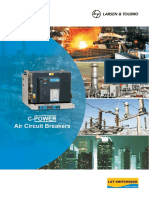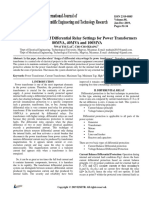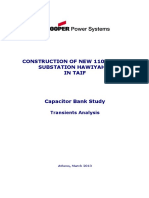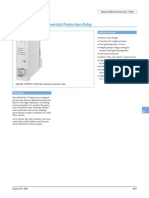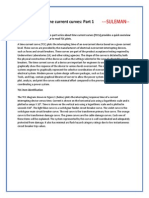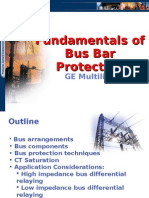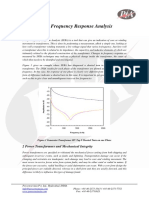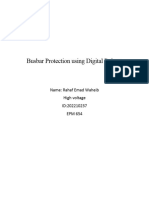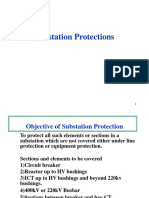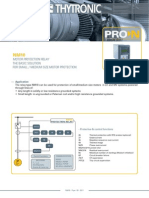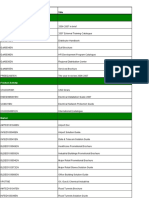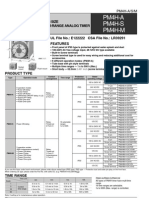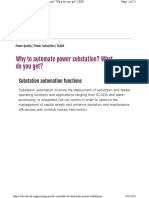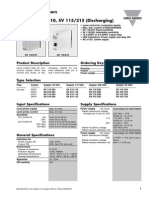BUS BAR PROTECTION
By AJIT PRATAP SINGH
�Profile
Passed B.Tech in Electrical Engg.(with honors) from IT-BHU, Varanasi in 1994. Worked with Telco,Jamshedpur from July 1994 till Dec95. Joined NTPC in Dec95. Worked in Electrical Erection and carried out erection of Switchyard & Generator Protection, Switchyard Equipments, Excitation system, Generator Bus-Duct for two and half years from year Jan 97 till July99 at NTPC Unchahar. Carried out commissioning & maintenance of Switchyard & Generator Protection, Switchyard Equipments, Excitation system for about four years from Aug99 till April03 at NTPC Unchahar. Working in the Protection Group at NTPC,EOC since May03
�FUNDAMENTALS
WHAT? WHERE? WHY? WHEN? HOW?
�What is Bus-Bar Protection?
Its a protection system which primarily protects bus-bars and associated equipments of transmission or distribution network substations/ switchyards from phase to phase or phase to earth faults.
back
�Where Bus-Bar Protection?
Transmission or distribution network substations / switchyards typically starting from 33KV and above.
back
�Why Bus-Bar protection?
Any substation is a pooling point or Node of several power sources. These power sources provide electricity to various consumers ranging from domestic to Industrial. For a fault in a substation bus- bars, all the sources feed this fault, which may be to the tune of 40KA even at 400KV Voltage level.
�Why Bus-Bar protection?
contd
If this fault is not cleared immediately: Associated equipments and bus-bars may get seriously damaged Network may get unstable and result into cascade tripping and grid collapse. HUGE NATIONAL LOSS!!!
back
�When Bus-Bar Protn Operates?
MUST operate very fast when fault is internal (operating time of 15 ms at 5 times set value). MUST NOT operate for external or Through fault. MUST be very stable during normal operating conditions
�When Bus-Bar Protn Operates?
contd
Substation to be protected
External/Through Fault
Internal Fault
prev
back
�How Bus-Bar Protn operates ?
KIRCHOFFs CURRENT LAW
�KIRCHOFFS CURRENT LAW
At every node, the sum of all currents entering a node must be equal zero. What this law means physically is that charge cannot accumulate in a node; what goes in must come out. i.e. I1 + I2 - I3 = 0 Or I1 + I2 = I3
Node
�KIRCHOFFS CURRENT LAW
contd
Substation to be protected
I1 I2
I3 I4 If
I1 + I2 = I3 + I4 If = I1 + I2 + I3 + I4
�How Bus-Bar Protn operates ?
contd
Substation to be protected
Trip Bus
Main-1
Main-2
�Operating Principle
Differential
�Types of Bus Bar Protection
High Impedance Differential protection Low impedance Differential protection
�High Impedance Differential
I1
Equipment to be protected I1 I2
i1 Stabilising Resistance Operating relay
i1 i1 i1 + i2
i1 i2
�High Impedance Differential
contd
VOLTAGE OPERATED CURRENT OPERATED ALL CT CONNECTIONS ARE LOOPED IN THE YARD AND SINGLE CABLE TAKEN TO THE RELAY AUGMENTATION IS EASY THROUGH FAULT STABILITY ACHIEVED THROUGH STABILISING RESISTORS CONNECTED IN THE RELAY CIRCUIT.
�High Impedance Differential
contd
Settings Vs = If(Rct+2 Rl) Vk not less than 2 x Vs Effective current setting Ir = Is+ nxIe Is= relay circuit current setting Ie= Magnetising curent N= No of CTs in parallel I pry = Ir X turns ratio
�High Impedance Differential
contd
CT Matching CT ratio to avoid spill current during healthy state Less Rct/ less Ie/high CT ratio Routing of CT connection Looped at the yard itself to ensure minimum loop resistance and thus a minimum setting voltage and a minimum Vk for a given stability limit
�Low Impedance Differential
I1
Equipment to be protected I1 I2
i1 Biasing/Restraining element Differential element i1 i1 i1 + i2
i1 i2
�Low Impedance Differential
Eqpt to be protected
�Low Impedance Differential
contd
Characteristics
Id= I1+I2+ Ib=ampl(I1)+ampl(I2)+
�Low Impedance Differential
contd
Uses Biased Differential Principle. Stability for through fault achieved by restraining quantities proportional to the feeder current.
�Low Impedance Differential
contd
CT wires directly to the relay CT mismatch (typ of the order of 1:5 ) can be accommodated. More suitable for numerical integrated protection systems as the CTs can be shared for many functions
�Standard Practice 400 kV
Duplicated main protection per zone (bus) Two prot connected to different CT cores Preferably, both main protections on different principles. Two out of two principle(main 1 & 2) for tripping.
��Standard Practice
contd
220 kV / 132 kV
One main protection per zone (bus) Single CT core is switched to respective main zone through switching relays Common check zone for all the buses connected to an independent CT core other than main protection Tripping based on operation of both main and check zone
�LOGIC OF MAIN AND TRANSFER BUS SYSTEM
��Numerical Bus Bar protection
Centralized: all functions in a centre unit Decentralized : Peripheral units attached to each bay and a central unit for scheme logic. Have many zones of protection in the same relay Many added functions like LBB, Feeder back up protection Event logging Disturbance recording
�Numerical Bus-Bar Protection
Central Unit
Peripheral Units
�Centralized Bus bar Protection
Hardwires
Bus Bar Protection Unit
Programming Unit
�Decentralized Bus bar Protection
Hardwires
Peripheral Units Optical fibre cables Central Unit
Programming Unit
���THANKS



